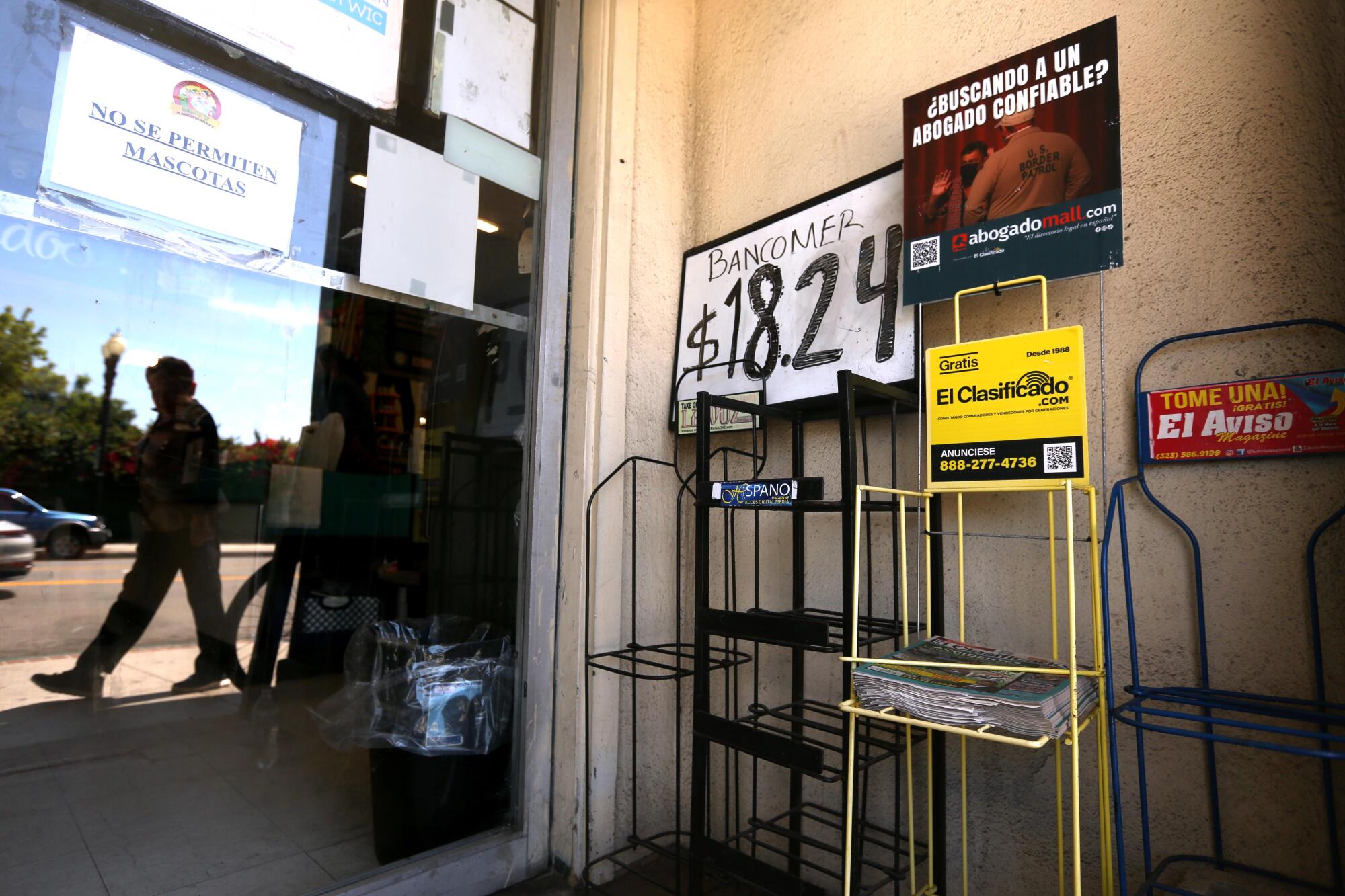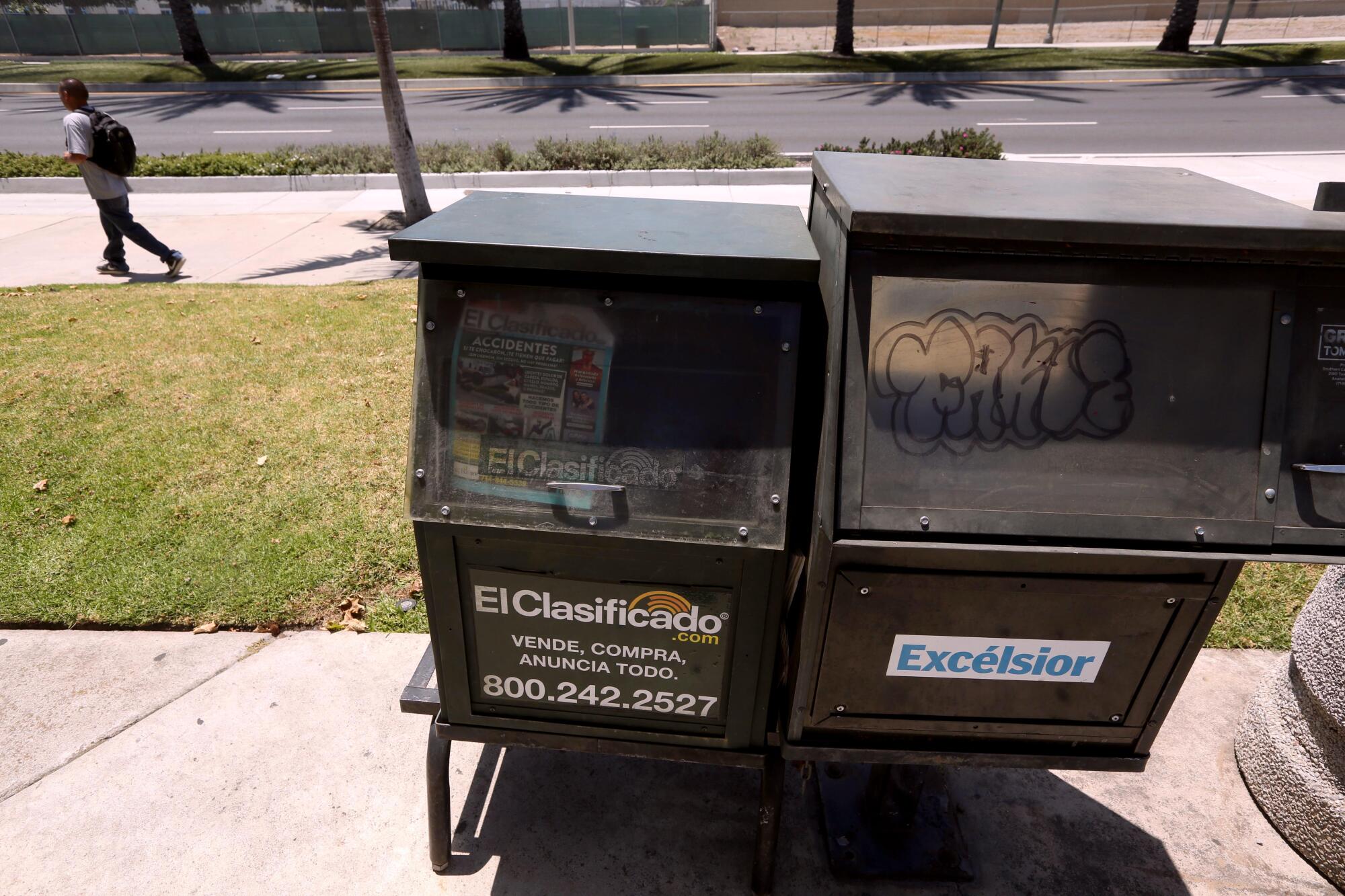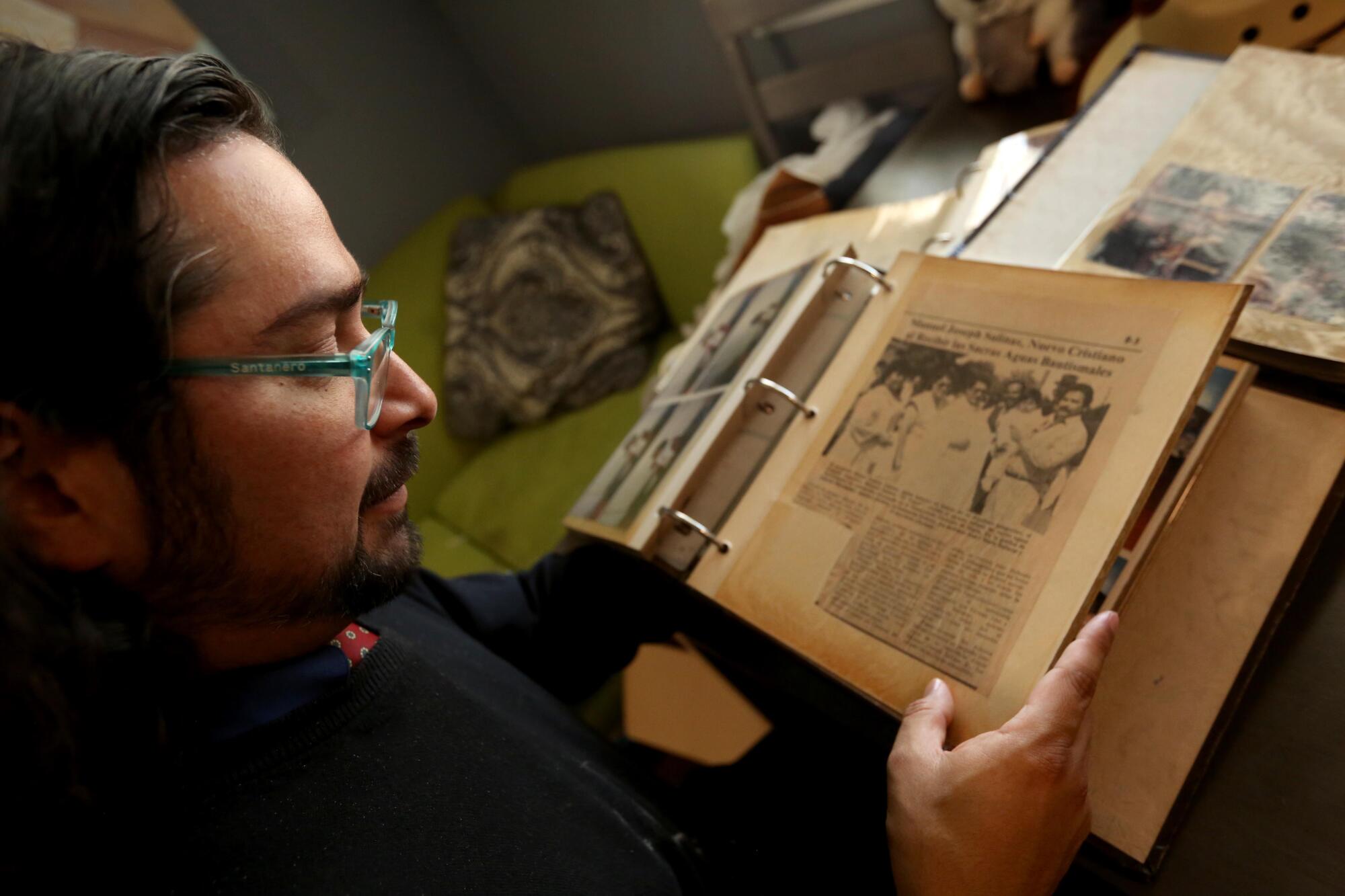
- Share via
When Laura Pantoja immigrated to Santa Ana from Mexico City in the early 1990s, she could choose from about a dozen local newspapers in her native language.
A literature major, she favored Unión Hispana because it was “the political paper,” sometimes printing unflattering photos of local elected officials who, editors thought, didn’t stand up for working-class Latinos.
Miniondas covered community groups and festivals, as well as city politics with a more objective lens. Azteca News was more interested in Latin American affairs than civic matters, while El Sol Latino published poetry and essays.
Then there was Rumores, which featured a bikini-clad woman on every cover while devoting its pages to salacious crimes and tales of the occult.
All except Miniondas were free weeklies. They helped readers navigate a new country while claiming a niche in a lucrative and highly competitive market in Orange County’s largest city, long a gateway for immigrants from Latin America.
The so-called semanarios jockeyed for position on newspaper racks in front of restaurants, mini-marts and liquor stores across town but especially on 4th Street, the downtown commercial district that catered to Latinos with beer bars, quinceañera shops and clothing stores.
“You’d pick up all the papers, take them back home and read them, and then do it again the following week,” Pantojo recalled recently.
Today, the teeming newspaper racks are almost all gone. The few that remain stand as rusting witnesses to the rise and fall of a media market that needs journalistic watchdogs more than ever, at a time when presidential candidates vie for the Latino vote and illegal immigration is a hot topic yet again.

During their heyday, Spanish-language newspapers in California thrived not only in metro areas like L.A., San José and San Diego but also in smaller cities, including Oxnard, Hanford, Pomona and Monterey.
When I began my journalism career in the early 2000s, covering Santa Ana for OC Weekly, the Spanish papers were my guide to deciphering a scrappy Latino enclave I barely knew, even though I grew up 15 minutes away in Anaheim. It was a rush for a newbie to compete with other reporters for scoops on stories that the English-language press usually followed up on without giving credit.
In addition to the semanarios, small magazines covered everything from Latin alternative music to local soccer leagues. The market was so lucrative that the Orange County Register published its own semanario, Excélsior, while The Times launched Hoy to compete with the venerable La Opinión.
My editor at the time suggested we open our own publication too. Thank God we didn’t, because those glory days crashed fast.
Pantoja volunteered to write the horoscope at Unión Hispana, then became a reporter. She covered the slew of anti-immigrant laws proposed in California during the 1990s before moving on to local issues like gang violence, housing and the creep of gentrification, until the paper closed in 2006.
The decline of Santa Ana’s Spanish-language newspapers largely mirrors that of their English counterparts, with revenue evaporating as a generation that gets information online or on social media finds no use for a print product. The move to digital has squeezed classified and display ad dollars that paid the bills. Meanwhile, the children of immigrants care little for the publications their parents once relied on.
Salinas’ last Spanish-language newspaper closed last year, and the San Diego Union-Tribune shuttered its Spanish edition in December. Today, only two Santa Ana-based Spanish-language publications remain, both monthly magazines focused on entertainment and lifestyle coverage: La Voz and a much-transformed Miniondas, which will celebrate 50 years in 2025. (Excélsior is still published online by the Register’s parent company, Southern California News Group, but it offers only stories translated from English.)
“Everyone thinks the abuse they suffer — housing, police, gang violence — happens only to them, so no one can do anything about it,” said Pantoja, 63, who now works as a community health organizer. “Nothing connects the community like newspapers.”
She still reads newspapers in English and Spanish — The Times, the San Francisco Chronicle, Mexico City’s left-leaning La Jornada — but all online and mostly about regional, national and international developments, because few local news sources remain.
“It’s a void that we as human beings can’t fill,” she said before quickly correcting herself.
“It gets filled with trash.”
From his wooden desk, Fernando Velo, the 42-year-old editor and publisher of Azteca News, can look out the office window and see the publishing battle going on in downtown Santa Ana.
In Orange County, the Register is a shell of its former self. The Times’ O.C. edition, which once ferociously competed with the Register, is no more. My former paper, OC Weekly, shuttered in 2019. Only two nonprofit news publications — Voice of OC and Culture OC — cover the whole county, while L.A.-based television stations are lucky if they have one reporter for a region of 3.2 million. The Times still covers the occasional news story in O.C. and operates a community newspaper, the Daily Pilot, that covers wealthy O.C. cities including Newport Beach and Huntington Beach.
Among Latinos, this news erosion has happened even faster, both locally and nationally.
A Pew Research Center study released this spring showed that 22% of Latinos nationwide follow the news closely, compared with 43% of white people and 35% of Black people. The study also found that Latinos favor getting their news from social media more than any other ethnic group, with only 4% preferring print.
Juan Esparza Loera, the longtime editor of the Fresno Bee’s Spanish-language publication, Vida en el Valle, said at least half a dozen newspapers served Spanish speakers in the area when he joined the Bee in 1994. He opened editions in Merced, Modesto, Stockton and Sacramento.
But Esparza Loera saw the proverbial writing on the wall about a decade ago, when he covered a baile folklorico performance.
“On the way to the office, I already saw people posting photos of the event on social media,” he said. “How can you compete with that?
Today, Fresno has one Spanish-language print newspaper: Pique, which publishes monthly.
Vida en el Valle announced this month that it was going digital only. The paper, which used to have six reporters, is down to Esparza Loera and one other person.
Now, he said, “it’s just survival.”
In one hand, Norma Yanez carried a sack of groceries.
The first periodical in Southern California was bilingual: the Los Angeles Star, which began publishing in 1851. Its Spanish content proved so popular that Star employee Francisco Ramirez spun off his own publication, the all-Spanish El Clamor Público, four years later.
“Every time there was a new community being built, you would start with a church, a post office and a newspaper,” said Manny Escamilla, who sits on Santa Ana’s historic resources commission and is the former head of the city’s history room. He has found evidence of Spanish-language publications in his hometown dating to the 1910s.

Like Pantoja, the 38-year-old vividly remembers semanarios available all over town, though he never picked them up because he preferred to read in English. Today, he treasures the clippings of family weddings and baptisms from Miniondas — including one of his own baptism — that relatives have kept in photo albums.
“Those types of stories and narratives only existed in those spaces — they told a very different side of the city,” Escamilla said. “If you only tell it through Anglo papers, that history is very skewed because of the historically conservative politics in Orange County.”
He mentioned an upcoming Santa Ana ballot measure that will ask whether residents who are not citizens should be allowed to vote in city elections.
“If you had a local, vibrant press, you’d have this much bigger discussion about it,” he said. “There would be front-page headlines and more people engaged.”
Instead, he says, most Santa Ana residents, Spanish-speaking and not, don’t even know about the measure. Too many people are instead fixated on national and international news from Facebook and YouTube — including his Spanish-speaking father. “He uses them more than I do,” Escamilla said with a bitter chuckle.
Kirk Whisler, founding president of the National Assn. of Hispanic Publications, is finishing a survey of more than 10,000 Latinos about their consumption of Latino-centric publications in English and Spanish. Preliminary results indicate that while 43% of readers want more local news, 47% would like to see more “success stories,” and an astounding 91% seek articles about health issues.
“The [Spanish-language newspapers] that are about lifestyle have stayed strong,” Whisler said, “while the ones that are primarily news have lost that market share.”
He brought up Miniondas, long seen as the most reputable of Santa Ana’s semanarios. It was founded in 1979 by Mexican immigrant Sergio Velazquez, and its circulation grew to 55,000 in the early 2000s. At its peak, it released two issues a week and published a separate entertainment publication, Farandula USA. For a while, it even included a few pages in English to try to grab the assimilated children of its core readers.

Velazquez sold his company to real estate agent Sandra Cervantes in 2012. In a news release announcing the ownership change, Cervantes vowed to take Miniondas “to the next level” with “information to the community that is relevant and informative.”
The most recent edition had a full-page story on Rihanna serving as a spokesperson for J’adore perfume, a piece about quarterback Tom Brady being inducted into the New England Patriots Hall of Fame and an essay praising Pixar’s “Inside Out” franchise for allowing people to speak freely about emotions. Only the essay included a byline. There was no hint of Miniondas’ past as a paper covering Santa Ana.
“In that evolution, it’s sad that Sandra didn’t prioritize keeping the articles that Sergio had had,” Whisler said. “I know you’ve still got that first-generation base there, and they’re not really being served the way they once were.”
Reached by phone, Cervantes declined to speak about Miniondas. Its only local competitor, La Voz, which has a similar mix of stories, didn’t respond to multiple requests for comment.
After talking to Pantoja and Escamilla, I drove around Santa Ana to look for a newspaper rack — any rack.
I walked around Bristol Street and McFadden Avenue, an unofficial Santa Ana town square where Escamilla once left ceramic bears in the racks so they wouldn’t look as empty — nothing.
I passed by El Toro Carniceria, which Pantoja once favored because nearly all of Santa Ana’s semanarios were available — nada. I drove to a Norms where newspaper boxes for The Times, Register, La Opinión and Excélsior used to greet diners as they entered — all gone.

At Novy Ranch Market downtown, I found three empty racks and another filled with untouched copies of El Clasificado, a Los Angeles-based Spanish-language version of the Pennysaver.
I then went to my local Northgate Gonzalez market, where I found Mina Beltrán sitting in her walker next to two newspaper racks. She flipped through a copy of El Aviso, another Los Angeles-based entertainment magazine.
The 71-year-old Mexican immigrant from the state of Guerrero said she would read newspapers and magazines regularly — her favorite was Azteca News “because the stories were well-written” — but stopped long ago “because they disappeared.” Nowadays, she gets her news mostly from television, radio “and whatever my friends tell me.”
Beltrán was reading El Aviso only because she was waiting for her daughter to finish shopping. With no smartphone to scroll, she tried to find something to enjoy in the glossy pages — an article about flying fishes, the horoscopes, a feature on male yeast infections.
After about five minutes, she put the magazine back on its rack and sat in silence.
More to Read
Sign up for Essential California
The most important California stories and recommendations in your inbox every morning.
You may occasionally receive promotional content from the Los Angeles Times.










